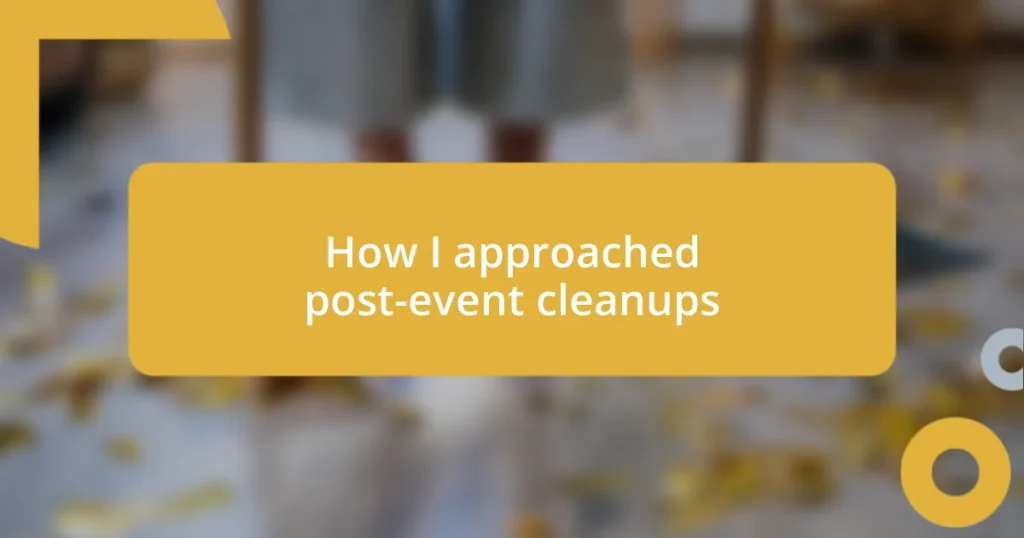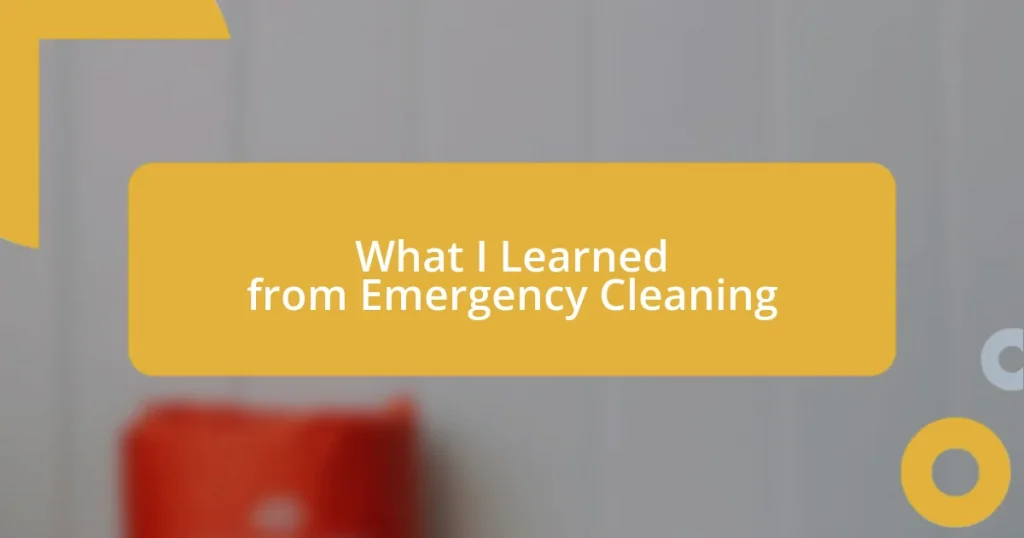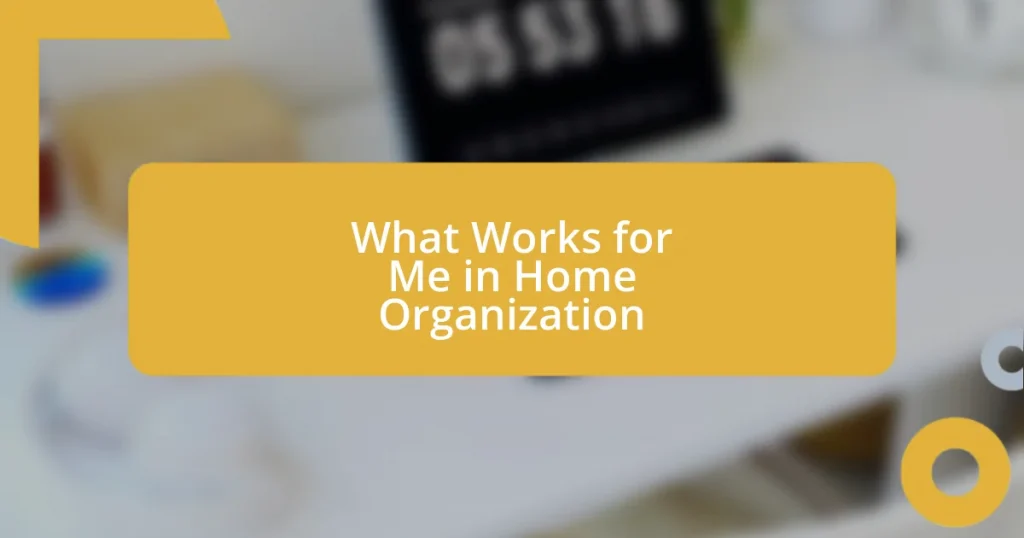Key takeaways:
- Effective planning for cleanups involves establishing a clear timeline, understanding team members’ strengths, and ensuring all necessary supplies are prepared in advance.
- Fostering team cohesion through communication and celebrating small accomplishments enhances morale and efficiency during cleanups.
- Gathering feedback post-cleanup and developing flexible improvement plans helps to refine strategies and encourages community engagement for future events.

How to plan for cleanups
Planning for cleanups may seem straightforward, but I’ve learned it requires thoughtful preparation. For instance, I remember one event where we didn’t allocate enough time between activities for cleaning. It left everyone scrambling at the end. Have you ever faced a similarly chaotic situation? Establishing a clear timeline can make all the difference.
Another crucial aspect is assembling the right team. I once organized a community festival without checking in with volunteers about their strengths and preferences. It turned out some were more suited for logistics while others thrived in creative roles, leading to a disjointed effort. Why not ask your team about their skills and preferences ahead of time? It fosters teamwork and ensures tasks are handled by those who genuinely enjoy them.
Finally, I can’t stress enough the importance of having the proper supplies on hand. During one memorable cleanup, we ran out of trash bags—an oversight that turned a simple task into a race against time. Imagine the relief I felt once I started creating a checklist of essential items. What items do you think are essential for a smooth cleanup? Preparing in advance leads to a more efficient process.

Key supplies for effective cleanups
When it comes to effective cleanups, having the right supplies ready can make all the difference. I can think back to an outdoor event where, amidst the fun and festivities, we used up our cleaning supplies too quickly. That brief panic when we realized we had only a handful of brooms and trash bags was unforgettable. It’s one of those moments that makes you recognize the importance of planning: knowing what you’ll actually need can save you from a last-minute scramble.
Here’s a quick list of essential supplies I recommend for seamless post-event cleanups:
- Trash bags (various sizes)
- Cleaning gloves (disposable or reusable)
- Brooms and dustpans
- Mops and buckets
- Sponges and cleaning solutions
- First aid kit (always good to have on hand)
- Recycling bins
- Water stations (keeping everyone hydrated boosts morale)
On that note, I’ve learned the value of keeping everything organized. Labeling bins and having a designated area for supplies helps streamline the process significantly. I still recall the gratitude I felt when everything was laid out clearly for my team; it transformed chaos into a coordinated effort. Without the right tools and a little planning, cleanups can feel overwhelming, but with preparation, they can actually become a shared communal experience.

Organizing the cleanup team
Organizing a cleanup team is about more than just assigning tasks—it’s about creating a sense of community. I remember one particular event where I realized that simply grouping volunteers together wasn’t enough. Instead, I initiated a couple of ice-breaking games to help everyone get to know one another before we started. This small effort transformed my group into a cohesive team. The atmosphere shifted from one of obligation to enjoyment. Have you ever seen how teamwork flourishes when people genuinely connect?
Another crucial point is communication. After a large event, I once fell into the pitfall of assuming everyone understood their roles perfectly. The result? Confusion reigned as team members drifted from one task to another without direction. To avoid this, I now emphasize clarity in communication. I write down everyone’s responsibilities, ensuring they’re physically distributed and easily accessible throughout the cleanup. This proactive step reduces chaos and instills confidence in the team. How have you handled misunderstandings in group projects?
Lastly, I’ve learned the undeniable value of celebrating accomplishments, even the small ones. While overseeing a cleanup, I made it a point to recognize my team’s efforts, like when they filled a significant number of bags or tackled a tricky area. A simple shout-out or a celebratory snack break lifted morale and encouraged everyone to keep going. After all, every cleanup task contributes to a more pleasant shared space, and acknowledging those efforts makes it less of a chore and more of a rewarding experience.
| Aspect | Details |
|---|---|
| Team Cohesion | Initiate ice-breaking activities to foster connections among volunteers. |
| Communication Clarity | Distribute clear responsibilities to avoid confusion during the cleanup. |
| Celebration of Efforts | Acknowledge accomplishments to boost morale and camaraderie. |

Strategies for efficient waste disposal
Efficient waste disposal requires a solid strategy right from the start. I’ve found that sorting waste into separate bins during an event not only speeds up the process but also encourages responsible disposal among attendees. Incorporating color-coded bins—one for recycling, one for compost, and another for general waste—can be visually engaging and educational. Have you noticed how eye-catching signage can actually motivate people to dispose of their waste properly?
Beyond sorting, timing is crucial. I recall a cleanup where we allocated specific slots for waste collection. Instead of waiting until the very end, we had team members roam the area periodically to collect trash, which made it feel less daunting. Think about it: smaller chunks of work can transform a seemingly never-ending task into manageable moments. Have you ever tackled a large project by breaking it down? It’s all about keeping momentum and energizing your team.
Lastly, don’t underestimate the power of technology in waste management. At a recent festival, we implemented a real-time tracking system to monitor waste levels in our bins. This allowed us to adjust our collection strategy on-the-fly, ensuring we stayed ahead of overflow issues. It felt fantastic to see our efforts translate into a cleaner space while minimizing our environmental impact. Have you explored tech solutions for your cleanup efforts? It can truly enhance efficiency and make the entire process feel more streamlined.

Best practices for recycling materials
Recycling materials effectively is not just about tossing items into the right bins; it’s about cultivating a mindset of sustainability. I distinctly remember a community event where we set aside time to educate volunteers on what could and couldn’t be recycled. We had a brief session highlighting the impact of recycling on our local environment, which truly resonated with everyone involved. Have you ever felt that spark of motivation when you understand how your actions create change?
One practice that has worked wonders is creating designated recycling stations with clear, engaging signage. At one festival I organized, we crafted signs with fun facts about recycling, which piqued many attendees’ interest. The result? More people chose to recycle simply because they were informed about its benefits. Isn’t it amazing how a little creativity can transform a mundane task into an opportunity for learning?
Lastly, I’ve learned the importance of post-event follow-ups regarding recycling efforts. After one major event, we sent out a survey asking attendees about their recycling practices and knowledge. Not only did this help us gauge the effectiveness of our recycling stations, but it also prompted discussions among participants about improving for the next event. How often do we seek feedback to enhance our future strategies? Engaging the community in this way not only promotes responsibility but also fosters a larger dialogue about sustainability.

Post-cleanup evaluation and feedback
Reflecting on the post-cleanup process, I’ve discovered that gathering feedback is as vital as the cleanup itself. After one particularly challenging event, I organized a debrief session with the team, where we openly discussed what went well and what could have been better. It surprised me how liberating it felt to share our experiences. Have you ever considered that these candid conversations can uncover small tweaks that lead to significant improvements next time?
In my experience, feedback from volunteers and attendees can reveal insights I might have overlooked. During one cleanup, I asked participants to jot down their thoughts on sticky notes as they departed. The variety of perspectives was eye-opening! It ranged from suggestions on equipment placement to comments on the overall atmosphere during the cleanup. I couldn’t believe how something as simple as asking for opinions could deepen community engagement. Have you thought about how feedback can spark new ideas and motivate others to participate in future events?
Moreover, I’ve learned to document these evaluations for reference. At an event last summer, I created a structured report summarizing our findings and shared it with the planning team. This document became an invaluable resource for future cleanups, providing a roadmap built on our previous experiences. Isn’t it fascinating how a single reflection can set the stage for even greater success? Embracing feedback isn’t just about improvement; it’s about fostering a culture of collaboration and growth.

Developing a cleanup improvement plan
When developing a cleanup improvement plan, I always emphasize the importance of setting clear, achievable goals. During one event, we aimed to reduce waste by 30%. To track our progress, I developed a simple checklist that allowed us to monitor how we were doing throughout the event. Have you ever noticed how having a clear target can focus efforts and boost morale?
As part of my strategy, involving the cleanup team early on to brainstorm ideas has proven beneficial. Once, after a particularly messy festival, I invited volunteers to share their thoughts on what could improve. Their insights led us to implement additional trash bins, which made a huge difference. Have you ever found that the people on the ground have the best ideas for tackling challenges?
Finally, I ensure that our cleanup improvement plan is flexible and adaptable. For instance, if something isn’t working, like a recycling station that’s routinely overlooked, I’m quick to reassess and pivot our approach. In one case, we repositioned our stations to be more visible based on feedback, resulting in a significant uptick in recycling rates. Isn’t it empowering to realize that with a little willingness to adapt, we can make a substantial impact?















